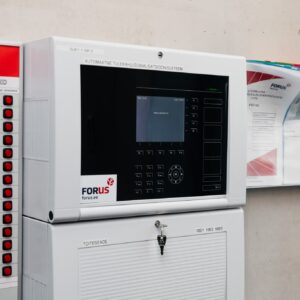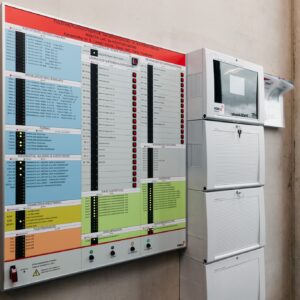Construction and installation of special components of buildings

It is obligatory in many buildings due to the requirements of the Estonian Rescue Board and the Fire Safety Act.
Aiding in the early detection of a fire.
Saving lives and protecting property.
Instilling a sense of security in people.
Some buildings need it for a permit for use.
Automatic fire alarm systems (AFAS) are an essential part of the security system of a building. Sometimes, the reason for a fire could be a carelessly extinguished cigarette or an old electrical device. The latter are incidentally the most common reason for fires.
An AFAS includes various sensors which help to alert people in the building of a fire as quickly as possible. This saves lives and protects property. We at Forus want to ensure your day-to-day safety and offer our services in designing, installing, and maintaining an AFAS.
Fire alarm systems must be installed by a licensed company. We have security and fire protection systems installers with professional certification who are specialists in their field.
An AFAS is obligatory mostly at high-risk sites where a fire could threaten human lives and health and cause huge material damage. Among others:

An AFAS mostly consists of a central processing unit, sensors (smoke, temperature, flame, and fire sensors, among others), fire buttons, and alarms. The sensors detect a fire and automatically send this information to the central processing unit. The latter activates the alarms, notifies people in the building, and if necessary, the Emergency Response Centre of the fire. The central processing unit sends the alarm to the Emergency Response Centre or the administrator of the building.
Forus offers both conventional as well as addressable fire alarm systems. We cooperate with well-known producers, such as Esser and Bosch.

A conventional fire alarm system
Addressable fire alarm system
The price of an automatic fire alarm system (AFAS) depends on the type of property, its size, the number of people that usually occupy it, and the type of the system (conventional or addressable). The latter is more expensive because it enables to detect fires faster and better.
The system is only reliable when properly maintained. The owner is obligated to conclude a maintenance agreement with a competent provider, such as Forus. The system requires maintenance at least once a quarter.
Requirements applicable to an AFAS are stipulated in the regulation issued by the Minister of the Interior: ‘Requirements for a fire alarm system and buildings where the fire notice of an automatic fire alarm system must be directed to the Estonian Emergency Response Centre’.
